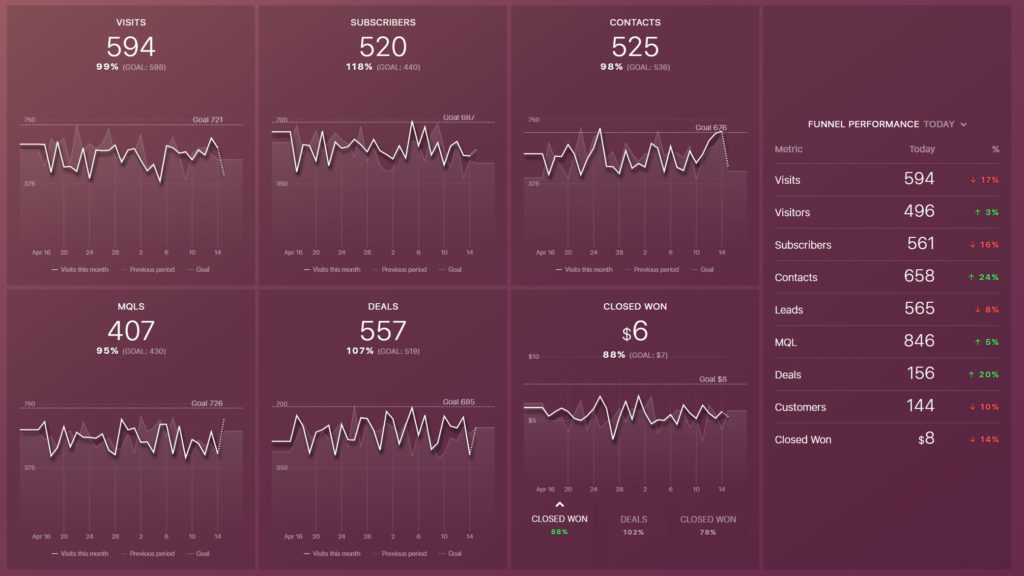
Written By:
Sean Henri
Marketing scorecards allow marketing teams to monitor their progress against their goals in real-time. With a scorecard, you can accurately identify your team’s strengths and areas of opportunity and adjust your efforts accordingly. There are 5 essential components of a CMO’s marketing scorecards, including:
-
Aligning with business objectives
-
Consistency and transparency
-
Storytelling through context
-
The ability to dive deeper
-
Reviewing and updating frequently
A marketing scorecard is a data driven marketing measurement tool that aligns activities to business strategy and allows teams to monitor and improve their inbound marketing over time. A scorecard is somewhat different than a dashboard as a dashboard simply provides you with a snapshot of performance at a particular moment in time without being aligned towards a specific goal or objective. The essence of the scorecard is that it scores your team’s progress rather than simply showing you numbers and charts.
There are many different types of scorecards that can be developed for a marketing team. The broadest view, and the one that is most closely aligned to marketing’s core purpose is the Marketing Performance Scorecard. It often contains most of the highest level key performance indicators (KPIs) such as reach, visits, marketing qualified leads, marketing contribution to revenue, cost-per-aquisition and ROI, making it the perfect view for the CMO or Head of Marketing at the organization.
Secondary scorecards might showcase channel performance, campaign performance, or progress towards key business initiatives or brand pillars. In this article we will use the Buyer’s Journey Scorecard as an example, but the same components should be applied to any scorecard you and your team develop.
#1) Align Your Scorecard to Key Objectives
The single most important aspect of your scorecard is that it must be tightly aligned to your business objectives. Bucket each set of metrics below a single objective. In the case of the buyer’s journey, this can represent each stage of your marketing funnel – Awareness, Consideration, Decision, Use and Loyalty.
You can make your chosen objectives far more meaningful by using the SMART methodology. SMART stands for specific, measurable, attainable, relevant and time-based. If you need help developing them, you can use this free template.
#2) Be Consistent And Transparent
Second in importance only to aligning with your objectives, your scorecard MUST be consistent in which data is presented and how that data is sourced. Consistency is important because without it you will find it nearly impossible to understand if you and your team are actually moving the needle in the right direction. Consistency also helps prevent the perception of any bias of cherry-picking of metrics, which is something marketers are often criticized for.
Reporting on the same metrics week after week and month after month will show that the marketing organization is focused and dedicated to their objectives. If your scorecard is focused on marketing channels or campaign performance, using similar or the same metrics across all channels will solidify the perception of fairness.
Transparency further quells any perception of favoritism or bias. If everyone who is contributing to the scorecard understands 1) why the metrics were chosen and 2) where and how the data is sourced, they will feel more comfortable that they are being measured fairly and for good reason. Sharing scorecards for all to see along with the documented methodology is a great way to increase transparency even further.
#3) Tell A Story Through Context
“I see that our cost-per-click is $5.67, but so what? Is that good or bad?” If you’ve ever sat through a monthly or quarterly review, you’ve probably heard a question like this before. Someone who views your scorecard should immediately have a sense of its meaning, and why you’ve chosen the metrics you’ve chosen. You can easily achieve this by including trends or comparison data, either month-over-month, or year-over-year to account for seasonality. If you’re just starting to collect data, consider using 3rd party benchmark data for your comparisons.
If you’ve mapped your scorecard metrics to key objectives and articulated your goals using SMART methodology, you’ll have an additional level of context that can help shape the story your data is trying to tell.
One last tip to try is to use color to visualize if the trend is positive or negative. If you’ve created your scorecard in Excel or Google Sheets, simply fill the cell with red if the change is negative or green if positive.
#4) Be Prepared To Drill Down If Necessary
SaaS solutions that automate scorecard data collection and visualization will often link over to the report or tool that the data is being sourced from. This allows you to quickly dive in deeper should questions arise around what might be causing a trend.
If you’re creating your scorecard manually, you can easily link reports in tools like Google Analytics or HubSpot, both of which do an amazing job at capturing and helping you understand activity along the buyers journey and let you create custom reports automate monthly runs that can be delivered via email. CSV reports can also be uploaded to Google Drive, and linked to from your scorecard for easy reference. However you end up doing it, the key is being able to back up your metrics with a deeper dive on a moment’s notice.
#5) Review and Update Regularly
“If a tree falls in a forest and no one is around to hear it, does it make a sound?” The same principle applies to marketing scorecards. If no one is looking at your scorecard, it becomes utterly pointless. You need to share your scorecard and share it widely, both within the marketing organization and with other departments as well.
Organizations that review scorecards on a weekly basis will see the greatest benefit. Think of a quarter long campaign. If you wait until the end of Q1 and the campaign fails, it’s too late! On the other hand, if you checked your scorecard after week 1, you may have caught that the targeting wasn’t quite right by seeing that your bounce rate was at 90%, and had the opportunity to modify your targeting to turn the campaign around for the remaining 11 weeks. If weekly is a bit too much, try a bi-weekly review.
If you really want to have a rockstar team, simply display the scorecard with a tool like Databox on a flat panel monitor on your office’s wall. This way everyone can see current scorecard 5 days a week without the need to schedule time for a formal review.

Bringing It All Together
Having these 5 essential components will go far in ensuring your scorecard process will drive improvements to your marketing’s performance and outcomes. If you’re convinced you need a scorecard but aren’t sure which metrics to include, start by defining your SMART goals. This will lead you to a primary KPI for each objective. You can then back off that KPI and define additional supporting metrics to include in each column.
Have some additional tips for developing scorecards or have a great example you’d like to share? Share it in the comments section below!






